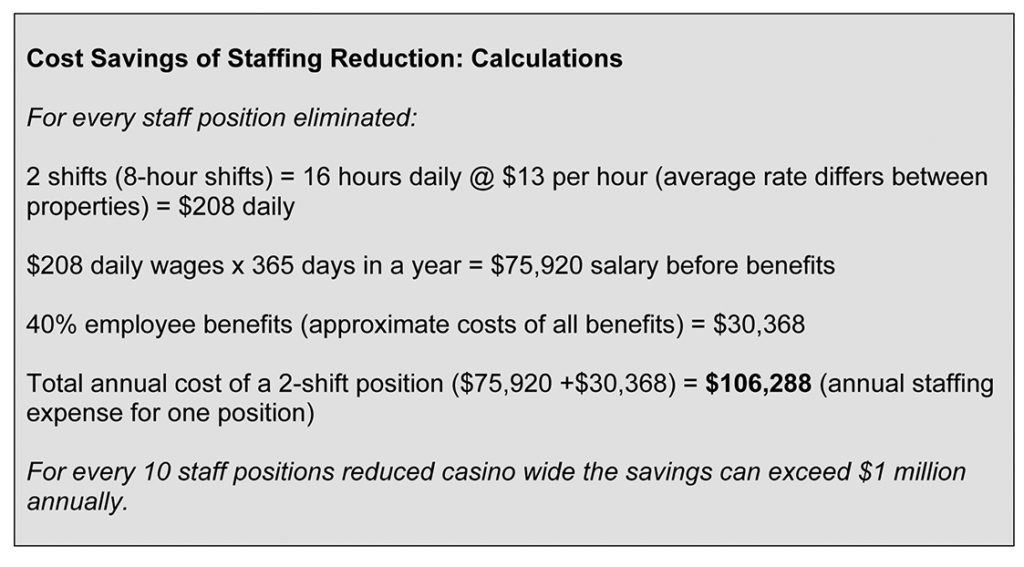by Craig Pendleton
Many casino leaders have reported that after reopening with limited operations, profits have been higher than pre-pandemic figures largely due to increased player time on gaming positions, the majority of customers being gaming focused and casinos keeping many amenities, including food and beverage outlets, closed or with reduced operations. This has allowed for considerable savings on labor, producing strong EBITA results. The amenities in the past that consistently lost money represent staffing level requirements that casinos never could afford.
Now is the time to reassess each amenity and determine which should be reopened and how they should be modified to avoid the costly “labor drain” of profits previously connected with them. Current staffing shortages may be an opportunity in addition to a challenge.
Why Staff is Reluctant to Return to Work Theories
• Some staff are still not comfortable returning to work during COVID-19 as it slows down but is not over. Some have chosen not to be vaccinated.
• Some operators feel that the extra weekly unemployment stimulus bonus of $300 is why workers will not return now, as some make the same amount of pay or more while staying at home.
• During the extended period of time staff members were off of work, they found other jobs that either pay better or are what they consider to be easier than hospitality positions at a casino or restaurant.
Regardless of the reasons that exist for each staff member, the fact remains that many are not returning to work in sufficient numbers, which hinders reopening of some elements of casinos. Increased wages are being attempted, signing bonuses offered, recruitment bonuses paid, but with limited success. Higher pay and bonuses may not provide long-term staff retention.
This is the time when major changes can be made without a tremendous amount of customer “push-back.” Smoking and buffets went away due to COVID-19. Some properties will bring them back and others will remain without. Reopening the same amenities without taking this opportunity for change will put things back where they were with amenities that drain casino profits and require a considerable amount of labor.
Choices in Resolving Staffing Shortages
• Wait for staff members to return and for new applicants.
• Hire staff that would not have been considered pre-COVID-19 and face the possible compromise of casino culture and the chance of a lower standard of hospitality service for customers and staff. This can have significant negative affects over time.
• Pay higher wages, bounties, hiring bonuses, recruiting bonuses and hope that these new staff members stay long-term, and that existing staff do not feel diminished because they don’t receive these bonuses though they have remained loyal and worked throughout the challenges.
• Consider reduction of outlets, reduction of operating hours, reinvention/re-concept of outlets and style of service, and/or restrict access of certain outlets to the highest value players.
• Outsource some services to better utilize existing numbers of staff.
• Install technology to reduce the demands on staff and increase efficiencies.
Steps to Analyze the Best Options
See What You Have
Calculate the minimum amount of staffing required in critical departments. Prioritize all jobs that are operationally necessary, such as gaming, engineering, security, surveillance, housekeeping and business oversight. Determine where the remaining unassigned staff members should best be applied.
Consider What Job Functions Can Be Performed by Other Parties Outside of the Casino
Decide what work could be completed by a third-party provider or be outsourced. Some of the areas for consideration within most casinos on a temporary or permanent basis are: accounting/payroll, PBX, IT, administration, elements of marketing/promotions, data analysis, elements of human resources, cleaning and preventative maintenance.
Determine areas that are the best fit for temporary outside services such as: box office/ticket sales, event set-up/breakdown, ushers, valet, exterior casino cleaning and engineering.
Consider cross-training existing staff for critical positions. Great staff members can be great in other areas.
Largest Areas of Opportunity That Can Reduce Staffing Requirements
Adjust the Style of Service of Amenity Outlets
Reassess style of service, operational systems, processes, steps to service, and integration and involvement of customers in some processes. Convert to simpler, smaller menus. Determine which food and beverage and other amenity outlets truly need to be full-service and which ones can be converted to more casual service.
Customers are now more used to casual service and quick service options. Ask the players of highest value what they want. Test conversions one outlet at a time and track the results by player to see if what the valued players tell you is true.
Full-service and casual service models have developed remarkably similar price points over time. This has resulted in even lower profit levels of the more labor-intensive full-service restaurants. Full-service dining should come at a higher menu price premium over quick service outlets. This is the time to install price differentiation between quick/casual service and full-service outlet menu pricing.
Add Technology
Use technology versus touches. The world is now acclimated to more touchless processes. Eliminate lines where possible. Give guests the capability to perform many operations themselves via kiosks, mobile apps, slot station interaction, online and email.
Install more technology including electronic ordering (handheld POS by staff and mobile app ordering by customers), electronic payment, customer pickup or use food runners for delivery.
Consider reducing or eliminating the use of cash by allowing money to be loaded onto players cards via electronic transfer at kiosks within the casino. Use cashiers and cage personnel only for large transactions. Consider chip redemption kiosks.
Track All Activity of Amenity Customers
Determine who the dining customers are. Do they represent positive revenues for the property via gaming and other activities or are they dining-only customers who cost the casino money and use resources such as parking and seating space that could be better used to support valued players? Track all activities including non-gaming transactions. Players cards are already used for point redemption – require players card use for all activities. This can be facilitated by incentivizing the use of cards for each transaction via tiered player discounts, earning points for each activity or simply being required for electronic transactions to speed up processes by using autofill from the player’s profile. Require players cards for reservations, preferred seating and, express lines based upon tier level. Consider utilizing a magnetic strip or embedded chip in players cards to allow quick swipe/tap processes.

Outsource Staff, Functions and Production
Outsource staff functions in areas that least affect guest experience interaction. Production of many food products can be outsourced. Products can still be produced using the chef’s proprietary recipes but made by an offsite supplier/commissary. Consider using existing products available from suppliers and simply modifying these products slightly to customize them; for example: soups, sauces and salad dressings. This does not mean a reduction of quality or the conversion to frozen, canned or dried mix products. This can still be a fresh chilled product program. Look at repetitious labor-intensive production such as vegetable preparation to determine what items can be purchased already prepared. For larger properties, shift all production that is not outsourced to one central commissary kitchen. Eliminate all back of the house prep in individual outlet kitchens. Line cooks should only be performing the final cooking steps of: broiling, grilling, frying, sautéing, deep-frying, plating and not acting as prep cooks. Reduction of staff in these areas will allow increasing wages for talented cooks and offering higher pay rates than the competition.
Physical Layout and Design Changes
Simply improving layout and minimizing steps, process and procedure can easily reduce staffing by a few staff members in outlets. Calculate the steps and distances required for each action element of service. Often, simply changing locations of supplies and combining steps can improve this process. Small remodels and adjusted layouts can provide a substantial impact and reduce labor requirements.
Today’s Staffing Shortage: Crisis or Opportunity?
Clearly both. There is no better time to make changes that make sense for your customers and your business. Whether the changes you make are temporary adjustments based on staffing conditions or permanent changes, there are a large number of opportunities available. Outlets with reduced processes can always be expanded in the future if staff becomes available and it makes business sense. Discovering new ways to dramatically change the processes and create savings to produce the same revenues will require a detached outside business perspective and input for multiple resources without relying solely on the operators who are close to their daily business and acclimated to current processes.
Craig Pendleton is President of National Foodservice Consulting, Inc. He has consulted for the past 28 years as a tribal casino specialist. He can be reached by email at [email protected] or visit www.nationalfoodserviceconsulting.com.














































